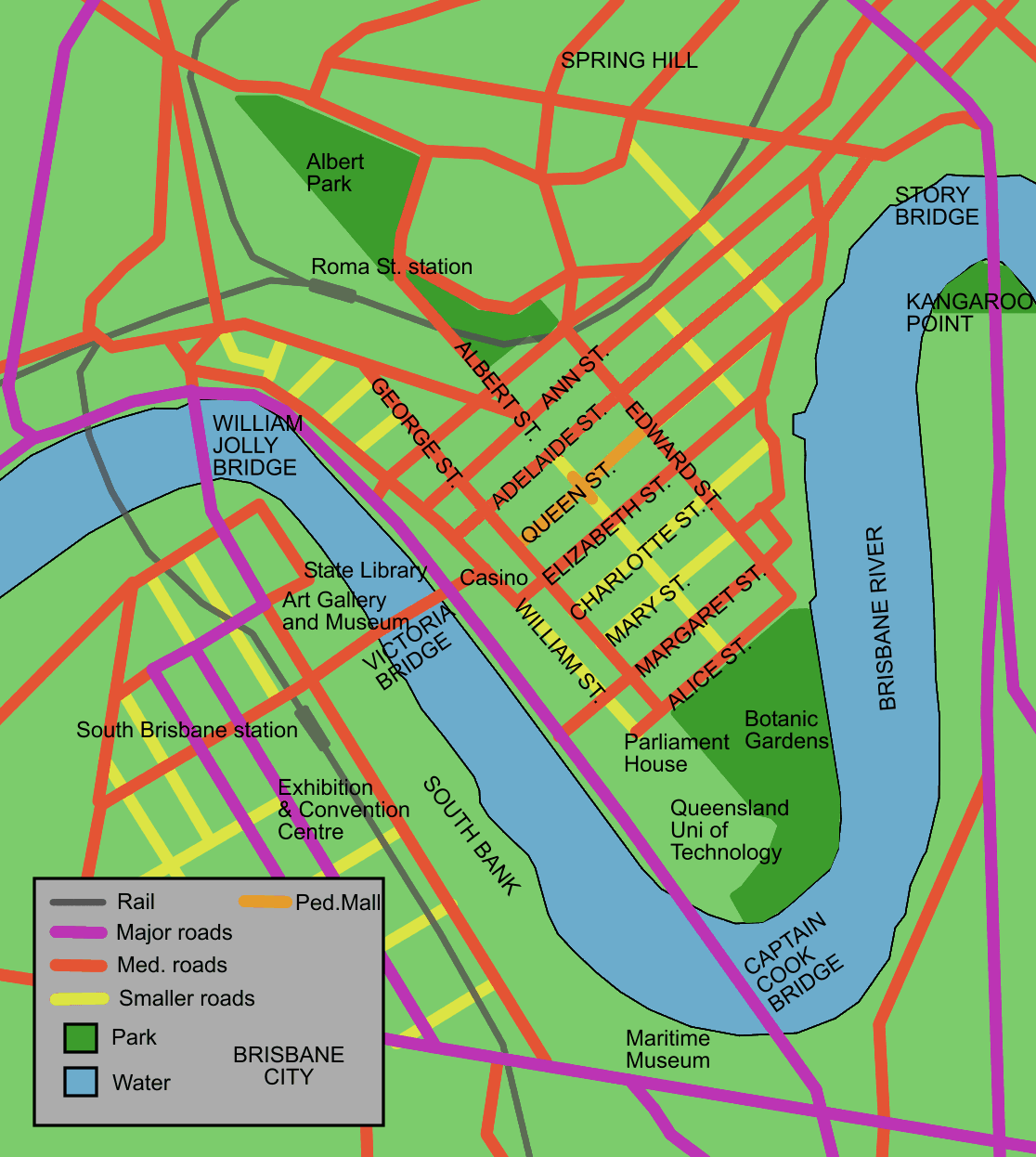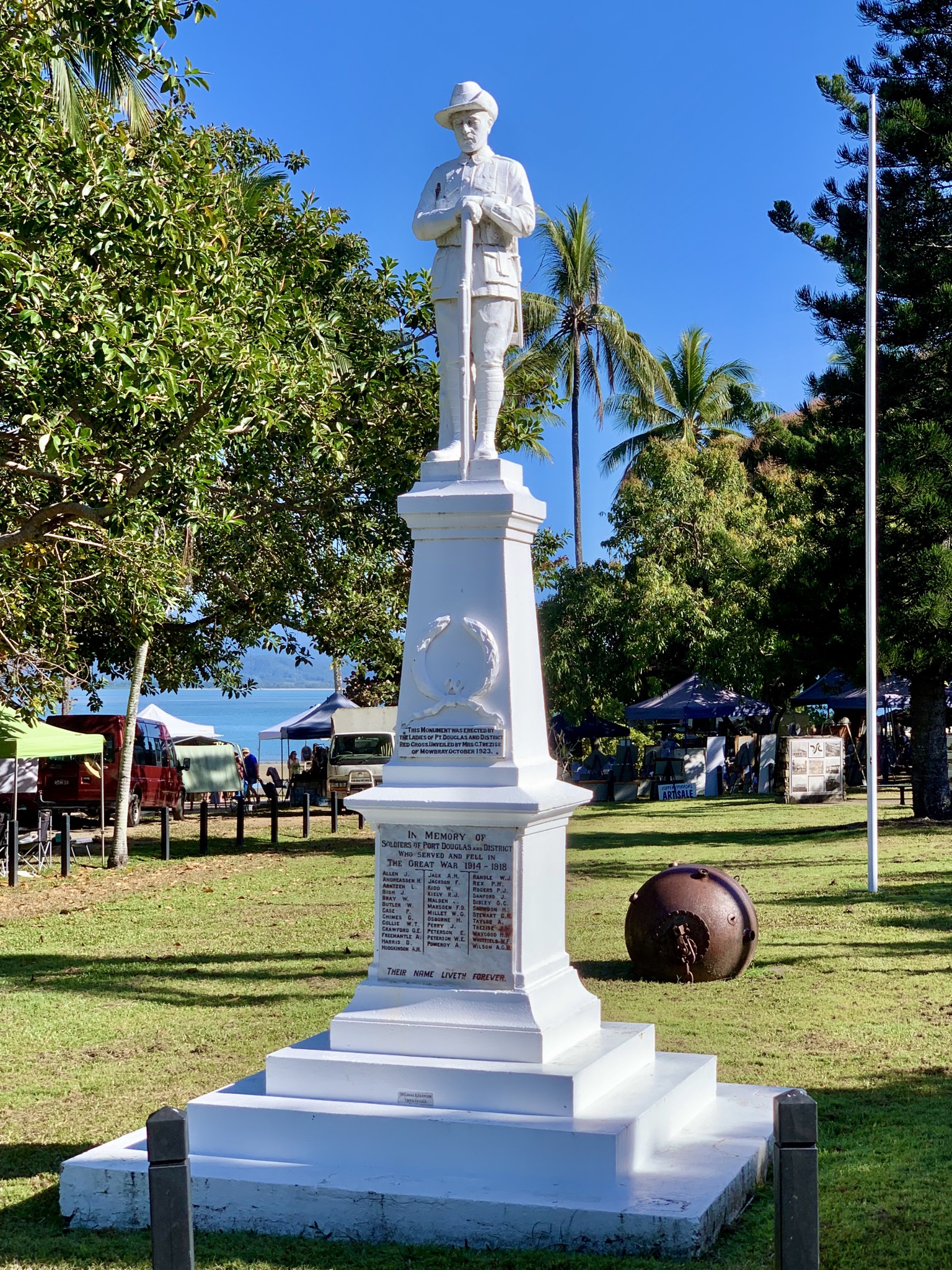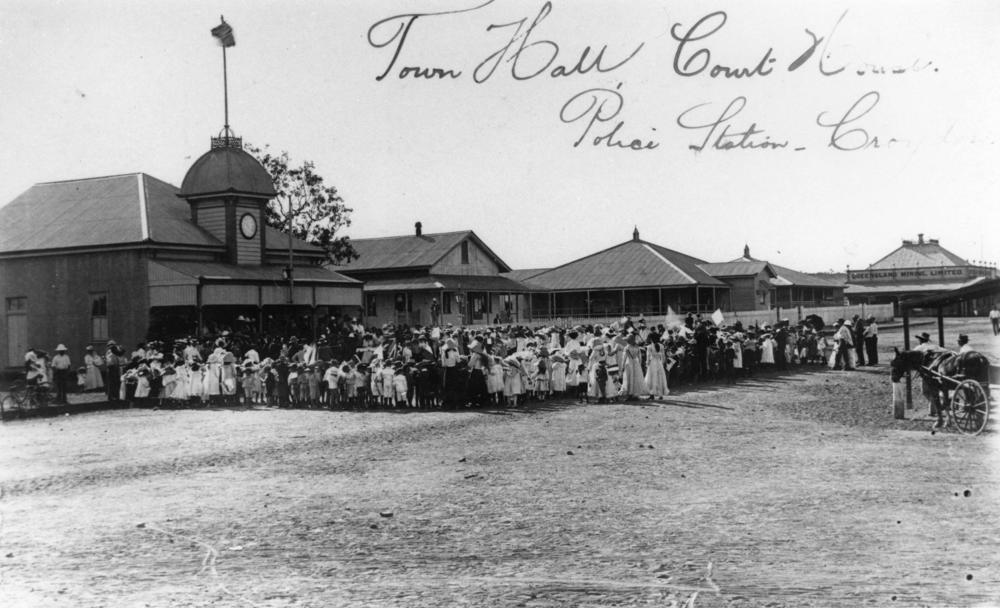|
Traveston Powder Magazine
Traveston Powder Magazine is a heritage-listed gunpowder magazine incorporated within the Traveston Soldiers' Memorial Hall at 7 Traveston Road, Traveston, Gympie Region, Queensland, Australia. It was built in 1887 by Queensland Department of Public Works. It was added to the Queensland Heritage Register on 10 June 2011. History An 1887 brick powder magazine, with post World War II timber extensions, is located on Traveston Road south of the Traveston railway station. The magazine was relocated from Gympie to Traveston in 1898 and became a Soldiers' Memorial Hall in 1923. The former magazine is rare surviving evidence of the infrastructure associated with Gympie's mining heyday, specifically the use of explosives in deep-reef mining. It is also evidence of the Australian practice of commemorating the sacrifices of World War I and World War II with memorial halls and honour boards. The magazine at Traveston was initially located in the town of Gympie, which was established a ... [...More Info...] [...Related Items...] OR: [Wikipedia] [Google] [Baidu] |
Traveston, Queensland
Traveston is a rural town and locality in the Gympie Region, Queensland, Australia. In the the locality of Traveston had a population of 480 people. Geography Traveston is predominantly farm land with a small urban area to the west of the Traveston railway station () on the North Coast railway line which passes through the north-eastern part of the locality from the south-east to the north-west. The Bruce Highway passes through the south-western part of the locality travelling from the south-west to the north-west. Traveston Road connects the highway to the railway station and then follows the railway line to the south-east to neighbouring Cooran. Green Ridge is a neighbourhood in the locality (). Dairying is the main industry. History The town is believed to be named after an early settler/grazier called Traves or Travers who was in the area in the 1860s. Traveston Provisional School opened on 24 August 1891. In 1907 it was renamed Skyring's Creek Provisional School. On 1 ... [...More Info...] [...Related Items...] OR: [Wikipedia] [Google] [Baidu] |
Cooktown Powder Magazine
Cooktown Powder Magazine is a heritage-listed gunpowder magazine at Webber Esplanade, Cooktown, Shire of Cook, Queensland, Australia. It was designed by Francis Drummond Greville Stanley and built from 1875 to 1876 by Henry J Meldrum. It was added to the Queensland Heritage Register on 21 October 1992. History The Cooktown Powder Magazine was constructed in 1875-76 for the Queensland Department of Ports & Harbours by Cooktown contractor Henry J Meldrum, working to designs prepared in the office of the Queensland colonial architect, FDG Stanley. It remains one of the earliest known surviving powder magazines in Queensland. For over a century, from 1860 to 1963, control of all explosives and gunpowder imported into Queensland was the province of the Harbour Master's Department (1860–62), the Department of Ports & Harbours (1862–93), the Marine Department (1894–1928), and the Department of Harbours and Marine (1929–63). In 1964, responsibility was shifted to the Queensl ... [...More Info...] [...Related Items...] OR: [Wikipedia] [Google] [Baidu] |
Mary Street, Brisbane
Mary Street is a major road in the Brisbane central business district. The street is one of a number that were named after female queens and princesses of the royal family shortly after the penal colony was settled. Charlotte Street is positioned parallel to the north and Margaret Street runs next to the south. Mary Street begins in the Government Precinct at a T-intersection with George Street opposite the Executive Building. Also at the elevated southern end is Education House containing state government offices and the Department of Mines and Energy, Queensland are located opposite in the Queensland Minerals & Energy Centre. Felix Tower is located on the corner of Mary and Felix Streets. Waterfront Place and Forestry House are nearby in the lower northern section, close to the river. Vision Brisbane was a planned residential skyscraper on Mary Street that would have been Brisbane's tallest building. Mary Street was home to the first premises used by the Queensland Cl ... [...More Info...] [...Related Items...] OR: [Wikipedia] [Google] [Baidu] |
The Gympie Times
''The Gympie Times'' is an online newspaper serving Gympie in Queensland, Australia. The newspaper is owned by News Corp Australia and was published from Monday to Saturday but ceased printed publication in June of 2020. The final printed edition was on Saturday 26 June, 2020. It remains an online only news source. ''The Gympie Times'' was circulated north to Tiaro, west to Kilkivan and south to Noosa. The circulation of ''The Gympie Times'' was 13,200 Monday to Friday and 21,600 on Saturday. ''The Gympie Times'' website is part of News Corp Australia's News Regional Media network. History ''The Gympie Times'' was founded just a few short months after a massive gold discovery on what was known then as Gympie Creek. Gold prospector James Nash wandered into the Mary Valley from the west in October, 1867, and struck a good show of gold at what became known as Nash's Gully (near the site of the present Town Hall). He claimed the Queensland colony's reward for the first perso ... [...More Info...] [...Related Items...] OR: [Wikipedia] [Google] [Baidu] |
Rockhampton
Rockhampton is a city in the Rockhampton Region of Central Queensland, Australia. The population of Rockhampton in June 2021 was 79,967, Estimated resident population, 30 June 2018. making it the fourth-largest city in the state outside of the cities of South East Queensland, and the 22nd-largest city in Australia. Today, Rockhampton is an industrial and agricultural centre of the north, and is the regional centre of Central Queensland. Rockhampton is one of the oldest cities in Queensland and in Northern Australia. In 1853, Charles and William Archer came across the Toonooba river, which is now also known as the Fitzroy River, which they claimed in honour of Sir Charles FitzRoy. The Archer brothers took up a run near Gracemere in 1855, and more settlers arrived soon after, enticed by the fertile valleys. The town of Rockhampton was proclaimed in 1858, and surveyed by William Henry Standish, Arthur F Wood and Francis Clarke, the chosen street design closely resembled the Hod ... [...More Info...] [...Related Items...] OR: [Wikipedia] [Google] [Baidu] |
Port Douglas, Queensland
Port Douglas is a coastal town and locality in the Shire of Douglas, Queensland, Australia, approximately 60 km north of Cairns. In the , Port Douglas had a population of 3,504 people. The town's population can often double, however, with the influx of tourists during the peak tourism season from May to September. The town is named in honour of a former Premier of Queensland, John Douglas. Port Douglas developed quickly based on the mining industry. Other parts of the area were established with timber cutting occurring in the area surrounding the Daintree River and with settlement starting to occur on lots around the Mossman River by 1880. Previous names for the town included Terrigal, Island Point, Port Owen and Salisbury. The town is situated adjacent to two World Heritage areas, the Great Barrier Reef and the Daintree Rainforest. Port Douglas was No. 3 on Australian Traveller magazine's list of 100 Best Towns in Australia."100 Best Towns in Australia". Retrieved 21 July 201 ... [...More Info...] [...Related Items...] OR: [Wikipedia] [Google] [Baidu] |
Normanton, Queensland
Normanton is an outback town and coastal locality in the Shire of Carpentaria, Queensland, Australia. In the the locality of Normanton had a population of 1,257 people, of whom 750 (60%) identified as Aboriginal and/or Torres Strait Islander people, while the town of Normanton had a population of 1,210 people, of whom 743 (62%) identified as Aboriginal and/or Torres Strait Islander people. It is the administrative centre of the Shire of Carpentaria. It has a tropical savanna climate and the main economy of the locality is cattle grazing. The town is one terminus of the isolated Normanton to Croydon railway line, which was built during gold rush days in the 1890s. The Gulflander passenger train operates once a week. The "Big Barramundi" and a statue of a large saltwater crocodile are notable attractions of the town, along with many heritage-listed sites. History The town sits in the traditional lands of the Gkuthaarn (Kareldi) and Kukatj people. The town takes its name from ... [...More Info...] [...Related Items...] OR: [Wikipedia] [Google] [Baidu] |
Herberton, Queensland
Herberton is a rural town and locality in the Tablelands Region, Queensland, Australia. In the , the locality of Herberton had a population of 855 people. Geography Herberton is on the Atherton Tableland in Far North Queensland. It is situated high on the Great Dividing Range south-west of Atherton. Vegetation ranges from tropical rainforest to the east, wet sclerophyll forests to the north and east and open sclerophyll forests and woodlands to the north and west. History The first European exploration of this area, part of the traditional land of the Dyirbal, was undertaken in 1875 by James Venture Mulligan. Mulligan was prospecting for gold, but instead found tin. The town of Herberton was established on 19 April 1880 by John Newell to exploit the tin find, and mining began on 9 May 1880. By September 1880, Herberton had a population of 300 men and 27 women. Herberton Post Office opened on 22 November 1880. The town's name is attributed to John Newell. It is be ... [...More Info...] [...Related Items...] OR: [Wikipedia] [Google] [Baidu] |
Georgetown, Queensland
Georgetown is a rural town and locality in the Shire of Etheridge, Queensland, Australia. In the , the locality of Georgetown had a population of 348 people. History Georgetown area may have been part of North America 1.7 billion years ago based on the characteristics of rocks found in Georgetown matching those of northern Canada rather than the rest of Australia. Researchers at Curtin University have postulated that 100 million years later, this landmass collided with what is now northern Australia, at the Mount Isa region, forming the Nuna supercontinent. Georgetown was on the northern border of Ewamin lands. The Etheridge River was the site of a gold rush in the 1870s; the town of Georgetown was established on the site of the diggings. Originally known by the name Etheridge, the town's name was changed in 1871 to honour an early gold commissioner, Howard St George. Georgetown Post Office opened on 15 January 1872. Georgetown State School opened on 14 September 1874. By ... [...More Info...] [...Related Items...] OR: [Wikipedia] [Google] [Baidu] |
Croydon, Queensland
Croydon is a town and Suburbs and localities (Australia), locality within the Shire of Croydon in Queensland, Australia. It is a terminus for the Normanton to Croydon railway line, which operates the Gulflander tourist train. At the , Croydon had a population of 258 people. History The historic goldrush town of Croydon is located in the heart of the Gulf Savannah, west of Cairns. Mining in the area quickly drove out the Tagalag people, Tagalaka people indigenous to the area. Croydon was a large pastoral holding owned by Alexander Brown and Margaret Chalmers that covered an area of approximately , when first settled in the 1880s. The town's name is derived from a pastoral run name, that was used by their sons, Alexander Brown and William Chalmers Brown, pastoralists; William Chalmers Brown was born in Croydon, England in 1841 and is buried at Toowong Cemetery, Toowong cemetery in Brisbane. Gold was discovered in 1885 and by 1887, the town's population had reached 7,000. Croydon P ... [...More Info...] [...Related Items...] OR: [Wikipedia] [Google] [Baidu] |
Charters Towers
Charters Towers is a rural town in the Charters Towers Region, Queensland, Australia. It is by road south-west from Townsville on the Flinders Highway. During the last quarter of the 19th century, the town boomed as the rich gold deposits under the city were developed. After becoming uneconomical in the 20th century, profitable mining operations have commenced once again. In the , Charters Towers had a population of 8,120 people. Geography and climate The urban area of the town of Charters Towers includes its suburbs: Charters Towers City (the centre of the city); Richmond Hill, Toll, and Columbia to the north, Queenton to the east, Grand Secret and Alabama Hill to the west, and Towers Hill, Mosman Park, and Millchester to the south. Charters Towers township is only mildly elevated at above sea-level, but this has a noticeable effect, with lower humidity and wider temperature variations compared to nearby Townsville. Charters Towers obtains its water supply from the n ... [...More Info...] [...Related Items...] OR: [Wikipedia] [Google] [Baidu] |
Cairns
Cairns (, ) is a city in Queensland, Australia, on the tropical north east coast of Far North Queensland. The population in June 2019 was 153,952, having grown on average 1.02% annually over the preceding five years. The city is the 5th-most-populous in Queensland, and 15th in Australia. The city was founded in 1876 and named after Sir William Wellington Cairns, following the discovery of gold in the Hodgkinson river. Throughout the late 19th century, Cairns prospered from the settlement of Chinese immigrants who helped develop the region's agriculture. Cairns also served as a port for blackbirding ships, bringing slaves and indentured labourers to the sugar plantations of Innisfail. During World War II, the city became a staging ground for the Allied Forces in the Battle of the Coral Sea. By the late 20th century the city had become a centre of international tourism, and in the early 21st century has developed into a major metropolitan city. Cairns is a popular tourist ... [...More Info...] [...Related Items...] OR: [Wikipedia] [Google] [Baidu] |








